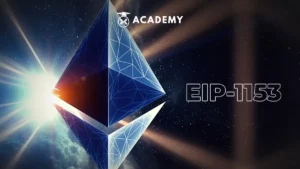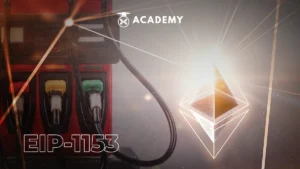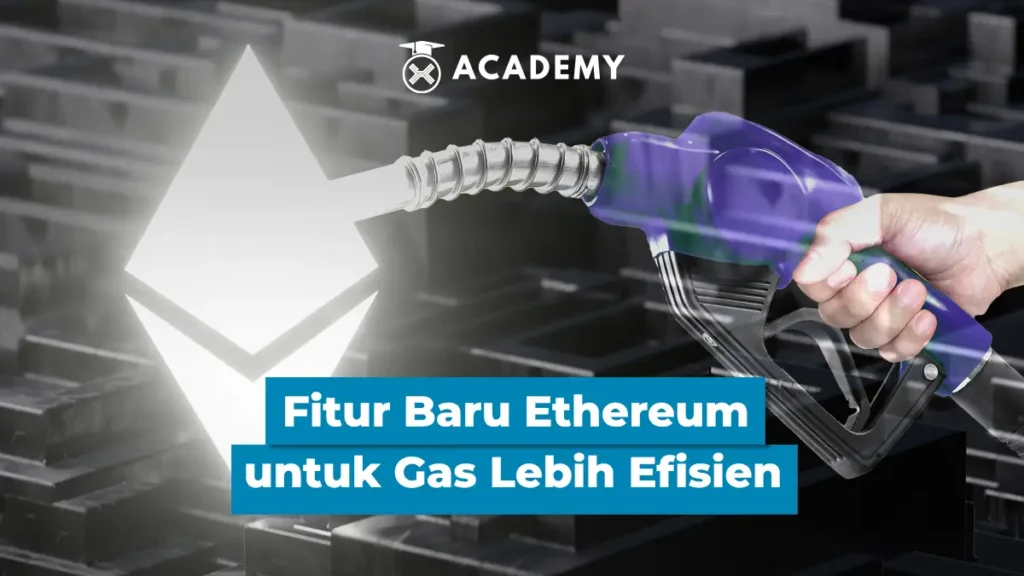As Ethereum gas fees skyrocket, developers and users are increasingly burdened. This is where EIP-1153 comes in, bringing a breath of fresh air.
This proposal introduces transient storage, an innovative feature designed to make smart contracts more efficient and cost-effective. So, what exactly is EIP-1153? Let’s discuss it in more depth.
Also read related articles: What is the Ethereum Improvement Proposal (EIP) & Its Impact
What is EIP-1153?

EIP-1153 is an Ethereum Improvement Proposal (EIP) that introduces a new feature to improve the efficiency of transaction data management on the Ethereum network.
Its main goal is to make smart contract execution more gas-efficient and efficient.
This proposal brings the concept of transient storage, a form of temporary storage specifically designed to reduce the cost of using permanent storage such as SSTORE which is known to be expensive.
EIP-1153 introduces two new opcodes, namely TSTORE and TLOAD. These two opcodes allow data to be stored only during the transaction process.
Once the transaction is executed, the data is automatically deleted. This means there is no long-term storage burden on the blockchain.
In concept, transient storage is similar to RAM in a computer, in that data is temporary and is immediately lost once it is no longer needed.
Because it does not need to be stored permanently on the node’s disk, this approach is a much lighter and more cost-effective solution than conventional storage methods on Ethereum.
Problems EIP-1153 Wants to Solve
While Ethereum is known for its flexibility, the gas cost of storing and modifying data remains a major challenge. For projects like NFTs, blockchain-based games, or DeFi applications, this cost burden can be very burdensome.
To get around this, many developers end up choosing inefficient solutions in order to keep their contracts running. Well, EIP-1153 is here to answer this problem in a more elegant way.
This proposal changes the way data is written and deleted during transactions, through a transient storage approach—a temporary data storage mechanism that is only active during a single transaction.
Compared to using permanent storage such as expensive SSTORE, transient storage is known to be much lighter and cheaper. Here are some of the main problems it tries to solve, namely:
- SSTORE is expensive ? making it difficult for projects to scale.
- Traditional storage slows down contract efficiency, especially in processes that involve many interactions.
- The absence of flexible temporary storage, even though many use cases require data to be temporary only for a single transaction.
With transient storage, smart contracts can now store data that is only valid for a single execution cycle—much like RAM in a computer. This is useful for a variety of purposes, including:
- Reentrancy locks, to mark processes during execution and prevent security holes.
- Token permissions, which allow for efficiency in managing token permissions.
- Callbacks and inter-contract interactions, where temporary data can be stored and then accessed between calls.
- Multi-step processes, such as games or complex transactions that require temporary variables.
- Transient voting, where the result of a vote is only relevant during the voting period.
- Temporary data buffers, for example for calculating scores before the final result is processed.
- Conditional logic, where reference values ??are stored during active transactions.
Aside from the benefits, there are also challenges. EIP-1153 adds new mechanisms to the EVM that can make auditing more complex.
However, if used correctly, this feature can significantly reduce gas costs without sacrificing application performance.
How Transient Storage Works in EIP-1153
The main feature of EIP-1153 is its ability to store temporary data that only lasts for a single transaction.
Simply put, data stored via transient storage will be automatically deleted once the transaction is complete without leaving a trace on the permanent blockchain. Here is a simple illustration:
Data stored? used? immediately lost.
With this mechanism, smart contracts can store values ??for use between functions or between calls in the same transaction, without having to pay a lot for permanent storage.
This solution is not only more efficient, but also secure because the data cannot be accessed or manipulated outside of the execution of the transaction. A simple example of its use is as follows:
TSTORE(0x01, 0xABCD);
TLOAD(0x01); // produces 0xABCD
Data such as 0xABCD only exists during the execution of this transaction. After that? Totally lost. This makes it ideal for internal logic, temporary data buffering, or processes that do not need to be stored permanently on the blockchain
Also read related articles: What is EIP-7594? Explanation and Impact on Ethereum.
Benefits of EIP-1153 for the Ethereum Ecosystem
Basically, this EIP can bring major changes to many parties on the Ethereum network, including the following:
1. Developers
With transient storage, developers can now build more efficient smart contracts without having to rely on expensive SSTORE.
Internal logic storage can be done without having to touch permanent storage, saving gas and simplifying contract design.
2. Investors & Users
Transactions become faster and lighter because smart contracts no longer need to write data to permanent storage for temporary things.
This means that the cost of interacting with DApps, such as DeFi, games, or NFTs, becomes much more affordable.
3. Ethereum Ecosystem
EIP-1153 opens the door to various new use cases that were previously less efficient.
An example is Uniswap v4, which will use a single smart contract for all liquidity pools—thanks to transient storage’s ability to efficiently manage data between swaps.
In addition, the proposal also helps reduce the overall storage burden on the network, which could make Ethereum more scalable and sustainable in the long run.
Who Proposed and Supports EIP-1153?
EIP-1153 was first proposed by an active developer team in the Ethereum community, specifically through Ethereum Magicians, in June 2018.
This proposal received strong support from the technical community, including Ethereum core developers, because it was considered capable of solving the storage efficiency problem with an elegant and practical approach.
Throughout the process, EIP-1153 has gone through various stages of discussion, opcode design revisions, and security testing before finally being adopted via a hard fork.
Its main supporters include teams developing major DeFi projects such as Uniswap v4, which immediately took advantage of this feature to create a leaner and cheaper liquidity system.
Which Projects Can Benefit?

EIP-1153 has great potential to benefit various types of projects in the Ethereum ecosystem, especially those that depend on cost efficiency and transaction speed, including the following:
1. On-chain games
Blockchain games that often require a lot of temporary data, such as player status or in-game variables, can feel the impact of this feature.
With transient storage, the data can be stored temporarily without burdening the network or gas fees.
2. DEX (Decentralized Exchange)
Decentralized exchanges, which manage many transactions and swaps between tokens at a time, can increase efficiency and reduce their operational costs.
By using EIP-1153, the process of managing liquidity and executing transactions can be much cheaper.
3. DeFi Protocols
DeFi protocols often run complex contracts in a single transaction, such as lending, borrowing, or staking.
They can use transient storage to temporarily store data that is only relevant in the context of that transaction, without burdening the network.
Comparison of EIP-1153 with Other EIPs
Here is a comparison table of EIP-1153 with Other EIPs
that you need to know:
| Aspect | EIP-1153 | EIP-2929 / EIP-2200 |
| Storage Type | Transient (sementara) | Persistent (permanen) |
| Gas Cost | Cheaper | More expensive to update |
| Objective | Internal efficiency of contracts | Gas cost recalibration |
The explanation regarding the comparison between EIP-1153 and EIP-2929 / EIP-2200 is as follows:
1. Storage Type
1.EIP-1153
EIP-1153 utilizes transient storage, which is a type of temporary storage that is only active during transaction execution.
Data stored with this method will be lost after the transaction is complete so as not to burden the blockchain with unnecessary data.
1.EIP-2929 / EIP-2200
EIP-2929 / EIP-2200 uses persistent storage, which means data is stored permanently on the blockchain.
This method is used by SSTORE to store data permanently, although the cost is higher because it requires more space on the Ethereum network.
2. Gas Fees
1.EIP-1153
Cheaper gas fees because there is no need to store data permanently. Temporary storage reduces storage space usage and optimizes transaction costs.
1.EIP-2929/EIP-2200
Higher gas costs, especially when there are updates to permanent storage (such as SSTORE).
EIP-2929 increases gas costs for more storage-intensive operations, and EIP-2200 recalibrates storage gas costs to reflect more realistic conditions.
3. Goals
1.EIP-1153
EIP-1153 focuses on contract internal efficiency, allowing smart contracts to operate more cost-efficiently by efficiently managing transient data without burdening the network.
This is especially useful in applications that require short-term data, such as DeFi and blockchain games.
1.EIP-2929/EIP-2200
Aims at gas cost recalibration, improving the gas costing mechanism for operations involving data storage.
The main goal of these two EIPs is to ensure that gas costs reflect the reality of storing more data on the Ethereum network, albeit at a higher cost.
Conclusion
That’s an interesting discussion about EIP-1153 which is a new Ethereum feature that you can learn more about only at the Crypto Academy. Not only does it add insight into investment, here you can also find the latest crypto news about the crypto world.
In conclusion, EIP-1153 is a strategic step in the evolution of the Ethereum network that leads to reduced gas fees and increased operational efficiency.
And for an easy and safe trading experience, download the best crypto application from INDODAX on the App Store or Google Play Store. You can also start buying Bitcoin, buying Ethereum, and other crypto assets practically in your grasp at INDODAX Market. Also follow INDODAX’s social media here: Instagram, X, Youtube & Telegram
5 FAQs
1.What is the difference between EIP-1153 and regular storage on Ethereum?
EIP-1153 stores data only temporarily during transactions, while regular storage stores data permanently on the blockchain.
2.Has EIP-1153 been implemented on the Ethereum mainnet?
As of 2025, this proposal is still under discussion and has not been fully implemented on the mainnet.
3.Why is EIP-1153 important for smart contract developers?
Because it can significantly reduce gas costs and make contract logic more efficient.
4.Does EIP-1153 make the blockchain lighter?
Yes, because it does not add permanent storage burden on the blockchain, only temporary.
5.Who should follow the development of EIP-1153?
Developers, investors, and crypto industry players who want to use Ethereum more efficiently.
Author: BOY





 Polkadot 8.90%
Polkadot 8.90%
 BNB 0.51%
BNB 0.51%
 Solana 4.86%
Solana 4.86%
 Ethereum 2.37%
Ethereum 2.37%
 Cardano 1.18%
Cardano 1.18%
 Polygon Ecosystem Token 2.14%
Polygon Ecosystem Token 2.14%
 Tron 2.85%
Tron 2.85%
 Market
Market


